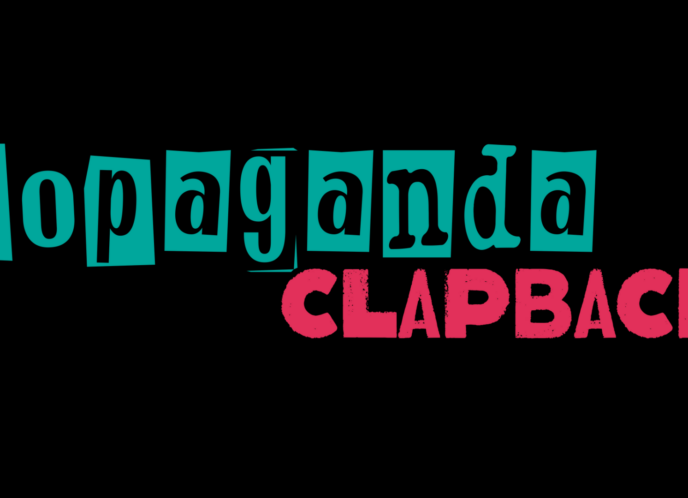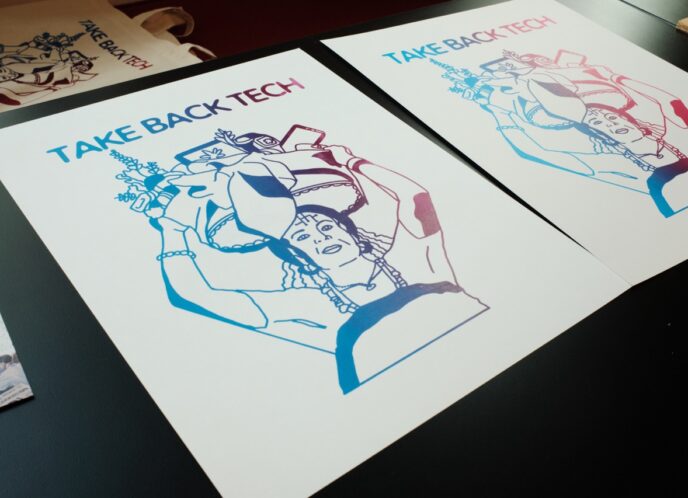Our communities see stories about crime everywhere, every day. It’s easy to be convinced that we live in a world with danger around every corner that only cops can protect us from, even though our lived experience proves otherwise. Today, the police are the most influential media figures in the country. True crime shows regularly top best-of-tv lists, while very real police violence– and the rhetoric justifying it– is replayed just a click or channel away. Media sensationalism and dehumanization of BIPOC people generates clicks for mainstream media companies, while the community-based media we’ve historically trusted have been replaced or drowned out. The police state (including police departments, police unions, foundations, legislators, and conservative thought-leaders) regularly use news coverage as a tactic to justify police brutality and surveillance. We need to discuss police generated propaganda, or as MediaJustice calls it, copaganda.
That’s why MediaJustice has teamed up with members of our MediaJustice Network and partners in the fight against racialized disinformation to produce the Copaganda Clapback! Curriculum, a resource for communities resisting pro-police propaganda. To learn more about why this curriculum is so important now, we asked MediaJustice National Organizer and one of Copaganda Clapback’s co-author, Rumsha Sajid, to answer a few questions:
- Why is this project important right now? How do you hope folks will use the Copaganda Clapback Curriculum in this political moment?
Copaganda is one of the biggest threats to our movements. Right now, we’re seeing the mass militarization of local police departments, an expansion of surveillance tools, and police brutality being fueled by copaganda. There’s been a mass uptick in copaganda since the Uprisings of 2020 and the movement to defund the police. Local news beats everywhere are dedicated to crime that distort how safe the world is right now. People are paranoid about their communities- copaganda fuels their fear. Now more than ever, people fear critical race theory, drag queens, and even public libraries. These fears are all rooted in making people fear one another and public space. It makes it so we only connect in privatized spaces, like online social media platforms or places we pay money to exist in. This project is necessary because it resists how copaganda leads to sterilization of our culture and our movement building.
Our hope with the resource is to build spaces for journalists, organizers, media makers, and researchers to come together to talk about copaganda. Instances of copaganda can be hyperlocal, so we’re co-hosting regional trainings across the country to build a container to discuss local solutions. I’m excited to be building with our grassroots MediaJustice Network to invest in those conversations with people who want to tell stories that challenge copaganda narratives, build relationships between organizers, journalists, and media makers, and to create their own information streams to share accurate information about policing.
- How have local communities/organizations contributed to the curriculum? Who contributed and how did it all come together?
We started the process of creating Copaganda Clapback in May 2022. We began doing listening sessions with nearly a dozen MediaJustice Network members across the country, asking what types of disinformation affect their work. Through those interviews, I learned that disinformation spread by police is some of the most harmful forms of disinformation affecting our movements. We then collaborated with our Network members, including: Line Break Media, CreaTV San Jose, and Generation Justice as members of the project team creating this curriculum. We met many times in the months following, identifying instances of copaganda in their communities for case studies as well as building out questions together for the activities in the curriculum.
- So what is copaganda? Is it a new threat and how people have clapped back in the past?
Copaganda is when police use their power to shape a narrative, especially with loaded or emotionally-charged language, in order to influence public opinion for their benefit. Copaganda is not a new threat. The origins of policing in the United States are rooted in preserving white supremacy and capitalism.
When I think of how people have “clapped back” against copaganda in the past, I think of fundamental ways Black and brown people around the world have 1) communicated about safety in subversive ways and have 2) kept themselves safe instead of relying on police. I think of The Green Book that Black people in the United States used to communicate about what routes were safe to travel through in the country. I think of the Arab Spring and how protestors used Twitter and social media to communicate to one another about police quelling their movement and kept each other safe. I think of the Gulabi Gang in India, a group of women who work together to hold men accountable for their physical violence against women. The housing movement in Spain when people squatted in empty bank-owned homes; they shamed banks for foreclosing homes and shamed police for pushing families out of their homes. All of these examples show how communities globally understand that police protect property, not people.
- What are some current examples of copaganda and/or the ways that movements are successfully winning against it?
The Stop Shotspotter campaign is a great example of a campaign that created major narrative shifts in how people think about surveillance and audio gunshot detection technology. Their organizing, both locally and nationally, is toxifying Shotspotter’s technology so much that the company changed their name and their stocks have hit an all time low. The campaign illustrates material wins in fighting back against copaganda narratives that push surveillance tools in our communities.
The Stop LAPD Spying Coalition, one of our Network members, has another example of countering copaganda. Their project called Watch the Watchers flips the lens of surveillance back onto police by indexing LAPD’s official records of its officers. Any person can engage in copwatch and countersurveillance through the resource.
Our comrade D.J. Hudson, MJ’s Digital Organizer, shared an example against copaganda from Cop City in Atlanta. Organizers in ATL successfully were able to subvert The Atlanta Journal-Constitution, a major local newspaper, by forcing them to call it “Cop City” instead of a “police training center.” Wins like this are major because news outlets across the country refer to it as “cop city” and it helps build the fight to show how harmful copy city’s creation is to their community.
- How have youth-led movements contributed to this curriculum? What can youth organizers and activists in particular do about copaganda?
We’re working with youth radio hosts and youth media makers from Generation Justice- one of the co-creators of this curriculum- based in Albuquerque. In addition to being part of our project team, we held a youth-only feedback session where we reviewed the first draft of the curriculum together and they offered integral feedback that shaped the final product. Their feedback has refined this curriculum a lot and I’m so grateful to work with them.
In terms of what youth can do about copaganda, I think of Yuri Kuchiyama’s words, “the most powerful weapon for we women of color is truth. Go out and tell the truth– everywhere.” Sharing their truth through whatever art form feels best is one of the most powerful ways to respond to copaganda. Steering clear of “community police programs” like basketball games with cops, ice cream with cops, and being critical of whatever way police officers try to connect with Black and brown youth is essential.
- What role, if any, does social media play in the creation and spread of copaganda? (CW: mention of murder by police below)
Social media totally plays a role. Our MediaJustice roots in the field of platform accountability started in 2017 because of our abolitionist approach to organizing against the harms of social media platforms. Before I joined the team, former MJ staff member Erin Shields led a campaign against Facebook’s censorship/surveillance after Facebook took down the livestream of Korrine Gaines’ murder by police.
Social media platforms continue to collude with police in order to quell our movements. Police across the country use social media to track organizers. And social media, though privately owned by Big Tech bros and billionaires, is often a tool for our people in our movements digitally relate to one another. People build relationships and movements on social media. Twitter, Facebook, Instagram are places where people often get sound-bites of political education without deep study. This can mean people end up supporting reformist measures that don’t get at the root of injustice.
- But I love Law & Order/CSI/911! Does this mean I should stop watching? How would somebody apply an abolitionist lens while watching tv in 2023?
We all have our problematic faves so I won’t tell you to not watch! We mention two resources in our curriculum: The first one is called Abolition on TV, an article written by our Narrative Director, Eteng Ettah. The other resource is called Normalizing Injustice by Color of Change which details the ways in which Hollywood spreads harmful narratives.
- People love data and statistics. How can we combat copaganda by the numbers? Is it possible to prove crime data inaccurate?
Totally. There’s a ton of data by movement groups across the country that show how inaccurate crime data can be and use liberatory data practices! For example, Lucy Parsons Lab does work on data transparency and police accountability. I also think about the fight against electronic monitoring led by James Kilgore, Danny Cendejas, Emmett Sanders, and Myaisha Hayes at MediaJustice. They’ve put together significant research that refutes many of the claims about ankle shackles, including how ineffective and harmful ankle shackles are for people by sharing people’s personal stories. It’s important to note that data and statistics are not just numbers; data is any kind of information– including our first-hand experiences.
Thank you Rumsha for sharing your thoughts!
You can hear more from Rumsha and the fellow co-authors of the Copaganda Clapback Curriculum at our national launch event on Wednesday, May 24th at 7pm ET! Join Team MediaJustice and our Network members: CreaTV San José, LineBreak Media, Generation Justice as well as our partners at the Tech and Social Change Project at the Harvard Shorenstein Center on Media, Politics and Public Policy and the Disinfo Defense League- as we discuss the process of creating this curriculum and how YOU can make waves in your community.



